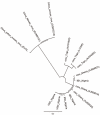Cacao swollen shoot virus detection and DNA barcoding of its vectors and putative vectors in Theobroma cacao L. by using polymerase chain reaction
- PMID: 36606145
- PMCID: PMC9645568
- DOI: 10.5114/bta.2021.108719
Cacao swollen shoot virus detection and DNA barcoding of its vectors and putative vectors in Theobroma cacao L. by using polymerase chain reaction
Abstract
Cacao swollen shoot virus (CSSV) is an endemic pathogen causing significant economic losses to cacao (Theobroma cacao L.) production in West Africa. There is limited updated report on the occurrence, spread, genetic diversity and species of CSSV and its mealybug vectors, especially in Nigeria. Nigeria is presently lagging behind in the search for resistance to CSSV and its vectors in T. cacao L. The present study aimed to map and screen for the presence of CSSV and its natural vectors - female mealybugs (Pseudococcidae: Hemiptera) in cacao plantations in Nigeria. Symptomatic and asymptomatic cacao leaves and whole female mealybug samples were collected from major cacao-growing areas in Nigeria - Abia, Akwa Ibom, Cross River, Edo, Ondo and Oyo States. A total of 2568 cacao leaves from 1052 cacao trees were screened with polymerase chain reaction (PCR) using an open reading frame 1 (ORF 1) CSSV-specific primer pair. PCR screening of the mealybug species was performed using the cytochrome c oxidase subunit I (COI) gene. A combination of scanning electron microscopy (SEM) and histology for morphological identification and DNA barcoding enabled to characterise the female mealybug species. The results revealed that CSSV and its mealybug vectors are present in the major cacaogrowing areas in Nigeria. Although CSSV and its vectors have been previously reported in Cross River, Ondo and Oyo States, our results present the first documented evidence of CSSV emergence and its mealybug vectors in Abia, Akwa Ibom and Edo States. We also present the first report of Pseudococcus jackbeardsleyi (Gimpel and Miller) mealybug species on cacao in Nigeria. In conclusion, it is pertinent to re-establish coordinated routine survey and monitoring of CSSV and its mealybug vector presence in T. cacao L. in Nigeria.
Keywords: COI – cytochrome coxidase subunit I; Cacao swollen shoot virus; DNA barcoding; Jack Beardsley mealybug; PCR – polymerase chain reaction; Theobroma cacao.
© 2021 Institute of Bioorganic Chemistry, Polish Academy of Sciences.
Figures










Similar articles
-
High-resolution melt and morphological analyses of mealybugs (Hemiptera: Pseudococcidae) from cacao: tools for the control of Cacao swollen shoot virus spread.Pest Manag Sci. 2016 Mar;72(3):527-33. doi: 10.1002/ps.4017. Epub 2015 May 11. Pest Manag Sci. 2016. PMID: 25827719
-
Mealybug (Hemiptera: Pseudococcidae) Species Associated with Cacao Mild Mosaic Virus and Evidence of Virus Acquisition.Insects. 2021 Nov 4;12(11):994. doi: 10.3390/insects12110994. Insects. 2021. PMID: 34821794 Free PMC article.
-
Geographical Distribution of Cacao swollen shoot virus Molecular Variability in Ghana.Plant Dis. 2016 Oct;100(10):2011-2017. doi: 10.1094/PDIS-01-16-0081-RE. Epub 2016 Jul 18. Plant Dis. 2016. PMID: 30682997
-
Cacao Swollen Shoot Viruses in Ghana.Plant Dis. 2023 May;107(5):1261-1278. doi: 10.1094/PDIS-10-22-2412-FE. Epub 2023 May 19. Plant Dis. 2023. PMID: 36510419 Review.
-
Chocolate Under Threat from Old and New Cacao Diseases.Phytopathology. 2019 Aug;109(8):1331-1343. doi: 10.1094/PHYTO-12-18-0477-RVW. Epub 2019 Jul 1. Phytopathology. 2019. PMID: 31115251 Review.
Cited by
-
Theobroma cacao Virome: Exploring Public RNA-Seq Data for Viral Discovery and Surveillance.Viruses. 2025 Apr 26;17(5):624. doi: 10.3390/v17050624. Viruses. 2025. PMID: 40431635 Free PMC article.
-
A barcode database for insects associated with the spread of the Cocoa Swollen Shoot Virus Disease in Côte d'Ivoire.Biodivers Data J. 2025 Mar 14;13:e144017. doi: 10.3897/BDJ.13.e144017. eCollection 2025. Biodivers Data J. 2025. PMID: 40125407 Free PMC article.
References
-
- Abd-Rabou S., Shalaby H., Germain J.F., Ris N., Kreiter P., Malausa T. (2012) Identification of mealybug pest species (Hemiptera: Pseudococcidae) in Egypt and France, using a DNA barcoding approach. Bull. Entomol. Res. 102(5): 515–523. - PubMed
-
- Ameyaw G.A. (2019) Management of the cacao swollen shoot virus (CSSV) menace in Ghana: the past, present and the future. [in:] Plant diseases-current threats and management trends. Ed. Topolovec-Pintarić S., IntechOpen. London.
-
- Banks H.J., Williams D.J. (1972) Use of the surfactant, Decon 90, in the preparation of coccids and other insects for microscopy. Aust. J. Entomol. 11(4): 347–348.
-
- Ben-Dov Y., Hodgson C.J. (1997) Soft scale insects; their biology, natural enemies and control. World Crop Pests 7A. Elsevier. Amsterdam.
-
- Bigger M. (1981) The relative abundance of the mealybug vectors (Hemiptera: Coccidae and Pseudococcidae) of Cocoa swollen shoot disease in Ghana. Bull. Entomol. Res. 71(3): 435–448.
LinkOut - more resources
Full Text Sources
